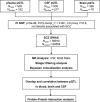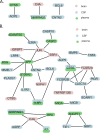Identifying novel proteins underlying schizophrenia via integrating pQTLs of the plasma, CSF, and brain with GWAS summary data
- PMID: 36482464
- PMCID: PMC9730613
- DOI: 10.1186/s12916-022-02679-5
Identifying novel proteins underlying schizophrenia via integrating pQTLs of the plasma, CSF, and brain with GWAS summary data
Abstract
Background: Schizophrenia (SCZ) is a chronic and severe mental illness with no cure so far. Mendelian randomization (MR) is a genetic method widely used to explore etiologies of complex traits. In the current study, we aimed to identify novel proteins underlying SCZ with a systematic analytical approach.
Methods: We integrated protein quantitative trait loci (pQTLs) of the brain, cerebrospinal fluid (CSF), and plasma with the latest and largest SCZ genome-wide association study (GWAS) via a systematic analytical framework, including two-sample MR analysis, Steiger filtering analysis, and Bayesian colocalization analysis.
Results: The genetically determined protein level of C4A/C4B (OR = 0.70, p = 1.66E-07) in the brain and ACP5 (OR = 0.42, p = 3.73E-05), CNTN2 (OR = 0.62, p = 2.57E-04), and PLA2G7 (OR = 0.71, p = 1.48E-04) in the CSF was associated with a lower risk of SCZ, while the genetically determined protein level of TIE1 (OR = 3.46, p = 4.76E-05), BCL6 (OR = 3.63, p = 1.59E-07), and MICB (OR = 4.49, p = 2.31E-11) in the CSF were associated with an increased risk for SCZ. Pathway enrichment analysis indicated that genetically determined proteins suggestively associated with SCZ were enriched in the biological process of the immune response.
Conclusion: In conclusion, we identified one protein in the brain and six proteins in the CSF that showed supporting evidence of being potentially associated with SCZ, which could provide insights into future mechanistic studies to find new treatments for the disease. Our results also supported the important role of neuroinflammation in the pathogenesis of SCZ.
Keywords: Complement 4; Mendelian randomization; Neuroinflammation; Protein quantitative trait loci; Schizophrenia.
© 2022. The Author(s).
Conflict of interest statement
The authors declare that they have no competing interests.
Figures



References
MeSH terms
Grants and funding
LinkOut - more resources
Full Text Sources
Medical
Miscellaneous

